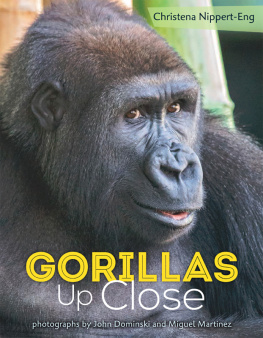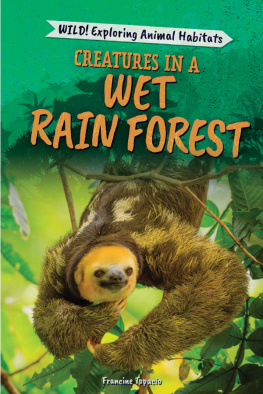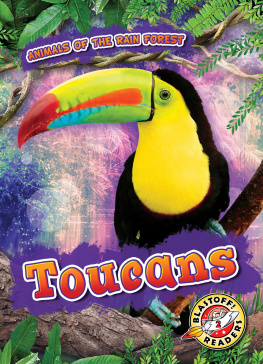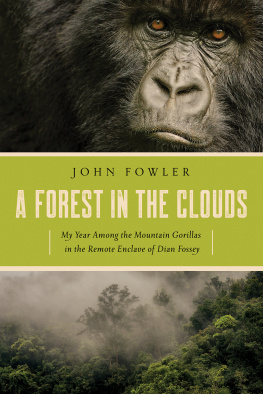rain forest wisdom
what gorillas tell us about ourselves
rain forest wisdom
what gorillas tell us about ourselves
by Andrew Y. Grant
illustrated by Zachary Horvath

I dedicate this book to all gorillas, to my friends, and my family group, especially Christan, Chad, Shannon, Jenny and my grandchildren Eva, Anthony, Lane, Charlie, Romi, and Flavin.
Andrew Y. Grant
RAIN FOREST WISDOM: What Gorillas Tell Us About Ourselves
Copyright by Andrew Y. Grant 2013.
Illustrations Copyright by Zachary Horvath 2013.
All rights reserved. No part of this book may be used or reproduced
in any way without written permission from the publisher, except in
cases of brief quotations in reviews.
Library of Congress Control Number: 2013947660
ISBN 13: 978-0981932194
Printed in the United States of America.
For author, publisher or special bulk-order enquiries:
Chris Sulavik
Tatra Press LLC
4 Park Trail
Croton-on-Hudson, NY 10520
Email: tatrapress@gmail.com
Book design and text composed by Stephanie Bart-Horvath.
Publishers Note: Much of the material in this book originally
appeared in Nearly Human: The Gorillas Guide to Good Living
(Tatra Press, 2007)

www.tatrapress.com
Contents
acknowledgments
Id like to express my deep appreciation not only to my family, but also to my publisher, Christopher Sulavik, for helping to shepherd this project from concept to book. His encouragement and support are greatly appreciated.
A special acknowledgment goes to Geoff Howard-Spink, whose enthusiasm and friendship were vital.
I am grateful for the work of the many talented and devoted people in this field who laid the groundwork for gorilla conservation, and I would like to acknowledge them, particularly: Dr. Dian Fossey, Dr. George Schaller, Dr. Jane Goodall, Dr. Penny Patterson, Dr. David Watts, Dr. Alice Honig, Dr. Kelly Stewart, Dr. Alexander Harcourt, Dr. Allison Fletcher, Dr. Juichi Yamagiwa, Dr. Alan Dixon, Bob Wiese, Carmi Penny, Yvonne of San Diego and the Consortium for the Reproduction of Miles, Christina Simmons and Dr. Martha Robbins.
Many thanks to the Zoological Society Endangered Species, especially Director Doug Myers, Ted Molter, Andy Philips, and Peggy Blessing, for their support and input. To Zachary Horvath, whose illustrations made the book come alive, and to Stephanie Bart-Horvath, who designed the book, thank you, and thanks to Erin Patterson for her editing.
I hope that when my grandchildren are old enough, they will have an opportunity to see gorillas in the wild.
introduction
Through the decades I have worked with zoos, I have long been fascinated by the wonders of all animals. Ive taken a special interest in endangered species and have been fortunate to contribute to efforts protecting them.
But, of all endangered species, its impossible to ignore one: the gorilla.
Although all animals are indeed created equal, the fact is that we humans, when visiting zoos, tend to hang out near the primate enclosuresespecially those with gorillas inside. Why? For myriad reasons, I suppose. Their size, their grace, their curiosity, their power. But mostly, I believe, there exists a search for a connection between people and gorillas. Ive seen this countless times, this special interspecies mutual appreciation. People try, in their quirky human ways, to bond with the gorillas. Gorillas, in turn, can connect with the fortunate among us.
Clearly, something profound happens when we and one of our closest relativesthe gorillashare cognitions. Despite all our differences, we see striking similarities. Through our mutual suspicions, we sense an odd kinship. Something happens, surely, and I suppose its different with different people. Some readers may embrace these similarities with interest and, hopefully, a knowing smile. Others may balk. Yet no one can ignore the overarching question that beckons when staring eye-to-eye with this amazing creature: How gorilla are we? And perhaps more important What do gorillas tell us about ourselvesabout being human?
I wrote this book to help make finding the answer a bit easier; to help come closer to understanding the wonders of this proud animal; and, possibly, to help us understand ourselves a little better.
I also endeavor to share what I believe are some of the most fascinating and important findings of hundreds of brilliant and tireless primatologists, anthropologists, and others. I cast a particularly bright light on the rich and admirable research and findings surrounding the mountain gorillas of the Virunga Mountains in equatorial Africa, where many dedicated scientists, including pioneers George Schaller and Dian Fossey, have been studying this captivating animal for more than four decades.
And, finally, theres the motivation that this book, to some degree, may help its subjectthe gorilla. If Rain Forest Wisdom can help raise public awareness of the gorilla, my hope is that it will also prompt conservation efforts and involvement in helping to protect this endangered species, as well as others. In a way, the gorilla provides us with vital clues to our own natures, as well as our successes and failures as a species.
I do believe that in many ways, the actions needed to save the gorilla are the same steps we need to take to save ourselves.
Andrew Y. Grant
Santa Barbara, California, 2013

note to reader
There are references throughout this book to the various gorilla subspecies. For details on nomenclature, taxonomy and distinguishing characteristics of these subspecies, please consult chapter six, gorilla nomenclature and species characteristics.
chapter one
growing up
The nostalgia of childhoodcutting through the neighbors yard to meet friends, coming home any time, as long as its before dark. Times have changed, and so, too, have childhoods, with fences going up restricting kids from the freedoms we remember.
Field studies tell us that young gorillas are given the space to explore, and that they need that space to be tireless learners and spirited playmates. They jump into situations with little or no prodding or guidance by parents. A good hunch is that theres some connection between the confidence of young gorillas and an upbringing filled with the freedom to grow at ones own pace.
But growing up is never easy, especially in the wild. Roughly half of the wild mountain gorilla population does not survive beyond the age of six. Young gorillas die early for a variety of reasons: they fall from trees, are attacked by predators, succumb to viruses, stillbirths, and poachers. There are still darker fates. Some mountain gorilla infant deaths are caused by infanticide perpetrated by males in order to acquire their mother, typically after she emigrates into a group with a child in tow.
Survivors are raised in a stable group, with loyal elders and an assemblage of kin, including half-siblings and even unrelated group members. By the time they can walk, most young gorillas have already absorbedoften through playadult-like traits, behaviors and skills.
Mastering these skills doesnt come through boot-camp discipline and training. It comes from learning with others. Together, gorillas learn everything from splitting a stem and removing the pith, to nest building, and grooming.
Next page












